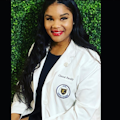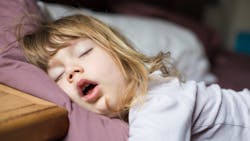Sleep apnea in pediatric and adolescent patients
Sleep apnea is often thought to be a disorder found only in adults. Research reveals that children may also suffer from sleep apnea, and if it is undiagnosed, it can lead to oral developmental issues. Approximately seven to nine million children experience pediatric obstructive sleep apnea (POSA) and suffer from sleep disordered breathing (SDB).1 Indications of childhood obstructive sleep apnea (OSA) are partial and/or complete blockage in the upper airway, commonly caused by adenotonsillar hypertrophy or enlarged tonsils.2
Research has shown that most cases among children and adolescents go unnoticed by parents or guardians. There is a direct correlation between POSA/SDB and the development of oral structures and speech and language outcomes for pediatric and adolescent patients. Early detection of POSA and SDB by dentists and a multidisciplinary team (physicians, orthodontists, and other health-care providers) can improve oral structure development in pediatric and adolescent patients that, if left untreated, could contribute to other health-related complications. The American Academy of Pediatric Dentistry lists common signs and symptoms of childhood OSA as loud snoring three or more nights per week, mouth breathing, and waking with dry mouth or sore throat.3
Prevalence according to gender and race
The highest prevalence of POSA and SDB cases are found in children between the ages of 3 and 5.1 Unlike adults, both sexes are equally affected; however, following puberty, POSA/SDB tends to be predominant in males. Because African-American children present with a steeper mandibular plane angle and steeper inclination of the anterior cranial base, they are at greater risk for POSA/SDB compared with Caucasians and Hispanics of similar age and body mass index (BMI).1
Health history
Childhood obesity is a risk factor for POSA/SDB and a growing concern. Obesity and POSA/SDB share many similar complications. Maintaining a healthy weight decreases the factors that contribute to POSA/SDB. As BMI increases, so does the risk of POSA/SDB.4 For every increase in BMI by one kg/m, the risk of POSA increases by 12%.1
Related reading
Waiting to exhale: Managing sleep apnea for the pediatric dental patient
Do ortho extractions lead to SDB or OSA?
Premature infants have traits such as high vaulted and narrow arched palates, which results in a higher risk of POSA/SDB during childhood. Approximately 50% to 80% of children with Down Syndrome experience POSA/SBD due to an enlargement of the tongue called macroglossia.1
Neurocognitive and neurobehavioral outcomes
Sleep bruxism (SB) is considered a parasomnia, which is a form of a neurocognitive disorder. There has been a disparity of information that connects bruxism to POSA/SDB.4 However, there is a high prevalence of patients reporting sleep bruxism when diagnosed with POSA/SDB. Studies have shown that approximately 14% to 17% of children grind their teeth while sleeping.5 Research revealed in a clinical sleep trial showed that up to half of pediatric and adolescent patients diagnosed with POSA/SDB experience sleep bruxism.1
Malocclusion
Malocclusion occurs when there is misalignment or improper fit of the upper and lower teeth upon closure of the jawbone. This disorder is usually detected by a dentist or dental hygienist and corrected by an orthodontist. SDB is associated with orofacial and dentofacial features related to malocclusion.6 Retrognathia is a risk factor for SDB because it obstructs the upper airway of the throat. Parents may be unaware of malocclusion and retrognathia and rarely report this disorder at primary care appointments. Routine dental appointments are needed to detect SDB and in an effort to reduce underdiagnosis of SDB and hopefully prevent detrimental long-term effects.
Time of diagnosis/treatment and solutions
Early detection of POSA/SDB is critical. Late diagnosis and treatment could delay verbal skills. Phonetic sounds are acquired from ages 3 to 6.7 This age span also corresponds to the enlargement (hypertrophy) of the tonsils, which is a risk factor for POSA/SDB.8 The most common underlying condition for POSA/SDB is the enlargement of the adenoids and tonsils.1 Due to the anatomy, dentists and dental hygienists are most likely to identify this abnormality and request further testing for diagnosis of POSA/SDB. Proper diagnosis to confirm POSA/SDB consists of history and physical evaluation of nighttime and daytime behaviors, physical examination of the face and neck, upper airway evaluation, home monitoring, and a polysomnography (PSG) test.
PSG has been suggested as the gold standard for the diagnosis of POSA/SDB in children and adolescents.2 The study of POSA/SDB is still evolving, with new options for treatment emerging. Physicians continue to monitor innovative treatment that will replace invasive treatment such as tonsillectomy and adenoidectomy (TA). Because obesity is the second most common cause of POSA/SDB, weight reduction is a common nonsurgical recommendation for these patients.1 The most common nonsurgical treatment options include continuous positive airway pressure (CPAP), myofunctional therapy, and if indicated, maxillary expansion, along with other dental/orthodontic treatment.9
Although research states that seven to nine million pediatric and adolescent patients are affected by sleep apnea,1 it is feared that many children remain undiagnosed. Dentists and dental hygienists need to become familiar with the signs and symptoms of POSA/SDB to screen and assess patients clinically for referral to a medical specialist.
Editor's note: This article appeared in the July 2022 print edition of RDH magazine. Dental hygienists in North America are eligible for a complimentary print subscription. Sign up here.
References
- Stauffer J, Okuji DM, Lichty II GC, et al. A review of pediatric obstructive sleep apnea and the role of the dentist. J Dent Sleep Med. 2018;5(4):111-130. org/10.15331/jdsm.7046
- Mohammed D, Park V, Bogaardt H, Docking K. The impact of childhood obstructive sleep apnea on speech and oral language development: a systematic review. Sleep Med. 2021;81(5):144-153. doi:10.1016/j.sleep.2021.02.015
- Policy on obstructive sleep apnea. The Reference Manual of Pediatric Dentistry. Chicago, Ill: American Academy of Pediatric Dentistry. 2021:123-126. https://www.aapd.org/media/Policies_Guidelines/P_SleepApnea.pdf
- Kuehne CA. Bruxism, obstructive sleep apnea and dentistry. J Calif Dent Assoc. 2020;48(4):195-197. https://www.cda.org/Portals/0/journal/journal_042020.pdf
- Children who grind their teeth are more likely to have problems in school, be withdrawn from others. American Academy of Sleep Medicine. Updated November 5, 2017. https://aasm.org/children-who-grind-their-teeth-are-more-likely-to-have-problems-in-school-be-withdrawn-from-others/
- Lyra MCA, Aguiar D, Paiva M, et al. Prevalence of sleep-disorder breathing and associations with malocclusion in children. J Clin Sleep Med. 2020;15(7):16. org/10.5664/jcsm.8370
- Speech sounds development chart. Kid Sense. https://childdevelopment.com.au/resources/child-development-charts/speech-sounds-developmental-chart/
- De Castro Correa C, Cavalheiro M, Maxinino L. et al. Sleep apnea and oral language disorders. Brazilian J Otorhinolaryngol. 2017;83(2):98-104. https://www.sciencedirect.com/science/article/pii/S1808869416300659
- Cielo CM, Gungor A. Treatment options for pediatric obstructive sleep apnea. Curr Probl Pediatr Adolesc Health Care. 2016;46(1):27-33. doi:10.1016/j.cppeds.2015.10.006
About the Author

La’ Donna D. Taylor, MS, RDH
La’ Donna D. Taylor is a licensed dental hygienist with 10+ years of experience. She currently working on her Doctorate of Health Science at the University of Bridgeport and is an adjunct clinical faculty member at East Tennessee State University.
